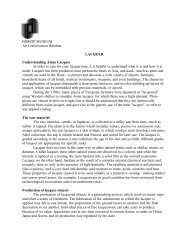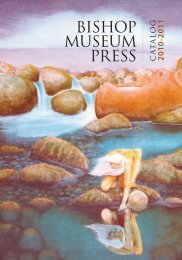INTRODUCED MARINE SPECIES IN PAGO ... - Bishop Museum
INTRODUCED MARINE SPECIES IN PAGO ... - Bishop Museum
INTRODUCED MARINE SPECIES IN PAGO ... - Bishop Museum
Create successful ePaper yourself
Turn your PDF publications into a flip-book with our unique Google optimized e-Paper software.
Skelton, P. A., Algae survey report<br />
Introduction<br />
Introduced Marine Species Survey in Pago Pago Harbor, American Samoa.<br />
ALGAE SURVEY REPORT<br />
By<br />
Posa A. Skelton<br />
International Ocean Institute (Australia)<br />
PO Box 1539<br />
Townsville, QLD 4810<br />
AUSTRALIA<br />
This report was prepared for the Bernice P. <strong>Bishop</strong> <strong>Museum</strong>, as part of the introduced marine<br />
species survey in American Samoa conducted in October 2002. The report analyzes the results<br />
of algal surveys from ten sites on Tutuila Island, American Samoa, to determine their status as<br />
invasive species.<br />
Algae are an important component of tropical reefs providing food for many organisms including<br />
humans, consolidating loose rubble, providing a niche for animals and plants, and complementing<br />
the array of colors that continues to entice visitors. They are also good environmental indicators<br />
especially when there is a change in the ecosystem such as increased nutrients or the absence<br />
of herbivores and grazers (Hatcher and Larkum 1983). One of the more serious threats to the<br />
marine environment is introduced invasive algae.<br />
Invasive algae have been documented in most oceans and seas. In the Mediterranean<br />
approximately 61 species are considered introduced, 28 in the Atlantic coast of Europe, 21 in<br />
New Zealand, and about 20 in Southern Australia (Ribera and Boudouresque 1995). Negative<br />
ecological impacts are known for some invasive algal species, for example Acanthophora<br />
spicifera, Avrainvillea amadelpha, Gracilaria salicornia and Hypnea musciformis in Hawai‘i (Smith<br />
et al. 2002), Undaria pinnatifida in New Zealand and Australia (Hay and Luckens 1987, Hay 1990,<br />
Sanderson 1990), Codium fragile ssp. tomentosoides in North America (Carlton and Scanlon<br />
1985), Sargassum muticum in Canada and Europe (Critchley et al. 1990), and Caulerpa taxifolia<br />
in the Mediterranean and South Australia (Meinesz and Hesse 1991). In the tropical seas<br />
introduced algae are poorly documented, except for the Hawaiian Islands. This may in part be<br />
attributed to the lack of expertise in the Pacific Island countries to accurately identify species and<br />
the low priority accorded to introduced species in the past. The smothering and subsequent<br />
weakening of the reef structure at Kan‘eohe Bay, Hawai‘i by the introduced Kappaphycus<br />
striatum (Smith pers. comm.) is of a grave concern as this alga (and other related Kappaphycus<br />
species) has been introduced to most Pacific Islands for cultivation (Skelton 1998).<br />
30






